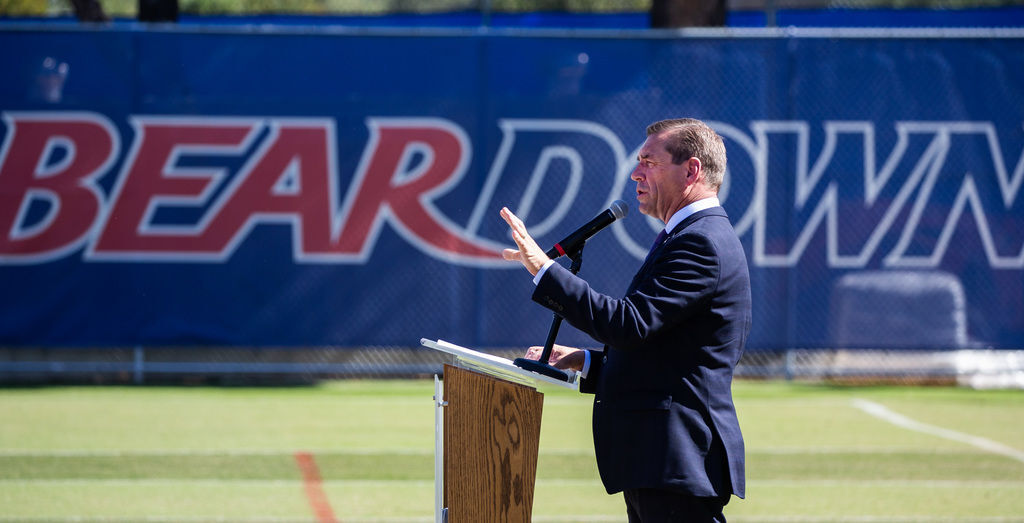Over the last 10 years, the UA athletic department has added almost 100 positions to its workforce, including the following:
assistant athletic director for strategic analysis and revenue generation;
basketball director for student-athlete development and analysis;
football manager for creative media;
coordinator for donor stewardship and services.
The combined salaries of those positions is a shade under $400,000.
The UA has increased the salary of its football defensive coordinator from $230,000 to $750,000.
The salary for its baseball pitching coach grew from $92,500 to $260,000.
A study of the school’s salary databases of 2010-11 and 2019-20 revealed that the athletic department grew at an unprecedented pace, from 156 full-time employees to 253, or a little over 62%.
Yet the growth and spending of Arizona”s athletic department over the last decade often didn’t keep pace with its Pac-12 rivals. Utah, for example, which began the decade in the smallish Mountain West Conference, recently created these five sports positions:
director of psychology and wellness;
assistant director of psychology and wellness;
coordinator of mental performance;
director of sports nutrition;
chief football dietitian.
The bottom line of Pac-12 athletic departments made you wonder if the oft-lavish spending was sustainable. And then — boom — the coronavirus pandemic offered a sobering answer: no.
Almost inevitably, UA athletic director Dave Heeke announced this week that he was eliminating 21 jobs and would not fill 15 open positions.
Earlier this year, Oregon State eliminated 23 athletic department jobs, Washington 16 and Washington State 10. When Colorado athletic director Rick George recently implemented staffwide salary reductions, layoffs and furloughs, he said: “This is the first time I haven’t enjoyed my job.”
Heeke similarly dreaded inevitable staff reductions, telling me last month “the thought of eliminating jobs keeps me awake at night.”
The Pac-12’s central office, known for its luxury spending, recently eliminated 18 jobs, which doesn’t include 76 layoffs/furloughs at the Pac-12 Networks.
The Pac-12 began the decade with 26 full-time employees under first-year commissioner Larry Scott. That number has almost doubled, to 49, which doesn’t include the Pac-12 Networks. It pays $9.6 million a year for rent of its downtown San Francisco headquarters.
Yes, $9.6 million a year.
Was all of this necessary? Did it improve the day-to-day life of the ballplayers, or did all of the improvements wind up in the pockets of coaches and administrators?
Deficit spending and debt service in college athletics has become so routine — if not necessary — it’s like a homeowner getting a second mortgage every year. Washington State and Oregon State both have reported a debt service in excess of $50 million.
In the fiscal year 2018-19, Arizona’s athletic department expenses were $85.7 million. Nine years earlier, they were $31.4 million.
Thanks to the Pac-12’s media rights deals with ESPN and Fox, schools like Arizona added positions for a director for football’s on-campus recruiting and analysis for $125,000. The men’s basketball department bumped the salaries of assistant coaches from $190,000 and $210,000 to $335,000 and $290,000.
The salaries for two associate athletic director positions grew from $97,000 to $185,000. A chief of staff was added for $282,200.
According to the salary data bases, the UA’s fundraising/development staff grew from 12 in 2010 to 22 today. The compliance staff doubled from three to six. In the last two years, Arizona has added a 10th full-time assistant football coach, for $185,000, and a football director of player development for $90,000.
And these additions merely kept Arizona in the mid to bottom level of Pac-12 spending. Keeping up with the Oregons, USCs and Stanfords requires more decimal points and commas than ever thought possible.
On Thursday, ESPN — which supplies close to 25% of annual revenue for a school like Arizona — announced it will eliminate 500 jobs. It, too, is restructuring its workforce much like Arizona and its Pac-12 partners.
It makes you ask this: Will Pac-12 sports ever return to pre-pandemic, flush-with-cash, money-is-no-object levels?
One of the first cost-saving measures adopted by the majority of Division I athletic departments was to end the practice of staying in luxury hotels the night before a home football game. That move will save many schools up to $90,000 annually.
But who knows where this will end and how many more jobs will be lost before it ends?
The capper to the Pac-12’s pandemic financial crisis arrived last week after an investigation by the Los Angeles Times revealed that UCLA — which doesn’t have any more money than Arizona or Cal or Colorado — spent $5.4 million in the 2018-19 school year for on-campus food for its football team.
That’s about $4.2 million more than Arizona spent for football pregame meals, post-practice snacks, training camp lunches and team breakfasts and dinners. The newspaper reported Chip Kelly’s football team consistently ordered from menus that included Cornish game hen, grass-fed flank steak and summer red snapper.
Under the direction of the athletic department’s performance nutrition coordinator, UCLA often paid $14.95 for simple peanut butter and jelly sandwiches. Its football team hasn’t had a winning season since 2015, but it did lead the league in fine dining.
When the price of PBJs becomes outrageous, it’s time to consider that the pre-pandemic finances of college sports were out of control.
As the 2020s move on, will every school be forced to view life through a business lens more than a wins-and-losses and academics-first lens? Or is that even possible any longer?





